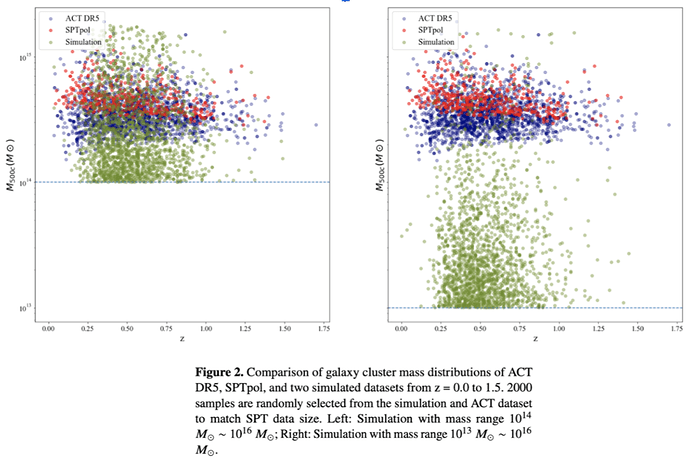Abstract: We assess the potential and limitations of simulation-based inference and deep learning approaches for analyzing simulated Sunyaev-Zel’dovich galaxy clusters. We use an analytic parameterization of the SZ signature to generate hyperfast and multi-fidelity simulations. Then, we use a variety of deep learning methods to perform inference on cluster mass, redshift, and non-thermal pressure fraction for a mass limited halo sample for a given cosmology. In this presentation, we focus on the simulations.
Co-authors
Brian Nord, Eve Vavagiakis, Ioana-Andreea Cristescu, Junhe Zhang, Hanzhi Tan
SZ Cluster Simulation: The thermal SZ profile is constructed using an empirical fitting function derived from hydrodynamical TreePM-SPH simulations (Battaglia et al., 2012). The submaps are then beam-convolved and noise is added to simulate data from Atacama Cosmology Telescope (ACT)(Thornton et al., 2016) and South Pole Telescope (SPT)(Carlstrom et al., 2011). We use aperture photometry to filter the Compton-Y submap with noise and extract the thermal SZ signal. The size of the aperture varies with redshift and is proportional to the angular diameter distance (Calafut et al., 2021).
Halo Simulation: The cluster mass dataset is an input to generate the SZ cluster catalog. The cosmology is given in Planck et al. (2015). We used a skewed gaussian distribution to imitate the redshift distribution in SPTpol 100d(Bleem el al., 2019), sliced the redshift range into slices with width 0.01, and allocated a sample number to every redshift slice based on the gaussian distribution. From the halo mass function (Bocquet et al., 2016), we created a likelihood function of mass for every redshift, simulated the cluster mass using Markov chain Monte Carlo(MCMC) Method, and excluded over massive clusters.
In Figure 2, we showed the comparison of two datasets generated from different mass ranges with the real data from SPTpol and ACT DR5. The dataset with mass range from 10^14 to 10^16 M⊙ is meant to imitate the real SZ cluster catalog. It is in good agreement with the real data but contains slightly more massive clusters over 10^15M⊙ than the real data due to the attributes of MCMC simulation. SZ galaxy cluster catalogs are S/N limited, thus resulted in a minimum mass cutoff of 10^14M⊙, while our simulations are not limited by. The other dataset with lower minimum of 10^13M⊙ is generated for machine learning purpose, which will provide interesting insights to parameters of low mass cluster.
Y-M Relation: Comparison of best-fit Y-M relations between simulation and recent SZ catalogs is ongoing.
Deep Learning and Next Steps: We are training a selection of deep learning networks to inference mass and other parameters using the simulated tSZ temperature submap / tSZ signal extracted with aperture photometry. Networks that we are training include Convolution Neural Network, DenseNet, ResNet, Bayesian Neural Network, and Simulation-Based Inference (SBI). We plan to provide multi-wavelength constraints on mass via optical and x-ray simulations.


